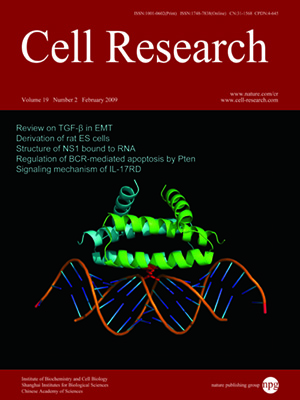
Volume 19, No 2, Feb 2009
ISSN: 1001-0602
EISSN: 1748-7838 2018
impact factor 17.848*
(Clarivate Analytics, 2019)
Volume 19 Issue 2, February 2009: 224-235
ORIGINAL ARTICLES
Overexpression of PGA37/MYB118 and MYB115 promotes vegetative-to-embryonic transition in Arabidopsis
Xingchun Wang1,2,*, Qi-Wen Niu3,*, Chong Teng1,2, Chao Li1,2, Jinye Mu1,2, Nam-Hai Chua3 and Jianru Zuo1
1State Key Laboratory of Plant Genomics and National Plant Gene Research Center (Beijing), Institute of Genetics and Developmental Biology, Chinese Academy of Sciences, Beijing 100101, China
2Graduate School, Chinese Academy of Sciences, Beijing 100049, China
3Laboratory of Plant Molecular Biology, The Rockefeller University, New York, NY 10021, USA
Correspondence: Jianru Zuo(jrzuo@genetics.ac.cn)
Formation of somatic embryos from non-germline cells is unique to higher plants and can be manipulated in a variety of species. Previous studies revealed that overexpression of several Arabidopsis genes, including WUSCHEL (WUS)/PLANT GROWTH ACTIVATOR6 (PGA6), BABY BOOM, LEAFY COTYLEDON1 (LEC1), and LEC2, is able to cause vegetative-to-embryonic transition or the formation of somatic embryos. Here, we report that a gain-of-function mutation in the Arabidopsis PGA37 gene, encoding the MYB118 transcription factor, induced vegetative-to-embryonic transition, the formation of somatic embryos from root explants, and an elevated LEC1 expression level. Double mutant analysis showed that WUS was not required for induction of somatic embryos by PGA37/MYB118. In addition, overexpression of MYB115, a homolog of PGA37/MYB118, caused a pga37-like phenotype. A myb118 myb115 double mutant did not show apparent developmental abnormalities. Collectively, these results suggest that PGA37/MYB118 and MYB115 promote vegetative-to-embryonic transition, through a signaling pathway independent of WUS.
Cell Research (2009) 19:224-235. doi: 10.1038/cr.2008.276; published online 12 August 2008
FULL TEXT | PDF
Browse 1976


